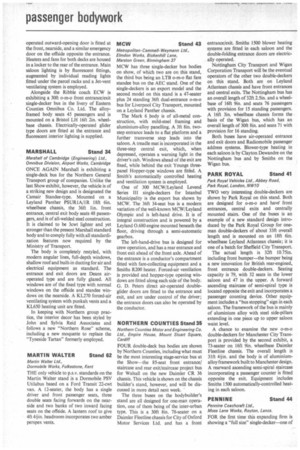MCW Stand 43
Page 190

If you've noticed an error in this article please click here to report it so we can fix it.
Metropolitan-Cammell-Weymann Ltd., Elmdon Works, Bickenhill Lane, Marston Green, Birmingham 37
MCW has three single-decker bus bodies on show, of which two are on this stand, the third bus being an LTB o-m-o flat fare standee bus on the AEC stand. One of the single-deckers is an export model and the second model on this stand is a 47-seater plus 24 standing 36ft dual-entrance o-m-o bus for Liverpool City Transport, mounted on a Leyland Panther chassis.
The Mark 6 body is of all-metal construction, with mild-steel framing and aluminium-alloy panelling. A 3ft 8in. twostep entrance leads to a flat platform and a further transverse step leads into the saloon. A treadle mat is incorporated in the three-step central exit, which, when depressed, operates a warning light in the driver's cab. Windows ahead of the exit are fixed, while behind the exit Youngs threepanel Hopper-type windows are fitted. A Smith's automatically controlled heating and ventilation system is employed.
One of 300 MCW/Leyland Levend Series HI single-deckers for Istanbul Municipality is the export bus shown by MCW. The 36ft 34-seat bus is a modem variation of the well-known MCW/Leyland Olympic and is left-hand drive. It is of integral construction and is powered by a Leyland 0.680 engine mounted beneath the floor, driving through a semi-automatic gearbox.
The left-hand-drive bus is designed for crew operation, and has a rear entrance and front exit ahead of the front axle. Ahead of the entrance is a conductor's compartment fitted with fare-collecting equipment and a Smiths R200 heater. Forced-air ventilation is provided and hopper-type opening windows are fitted along each side of the body. G. D. Peters direct air-operated doubleglider doors are fitted to the entrance and exit, and are under control of the driver; the entrance doors can also be operated by the conductor.


















































































































































































































































































































































































